Pb-Isotopic Study of Galena by LA-Q-ICP-MS: Testing a New Methodology with Applications to Base-Metal Sulphide Deposits
Abstract
:1. Introduction
2. Summary of the Bathurst Mining Camp Geology and Sampling
3. Methodology
3.1. LA-Q-ICP-MS Instrumentation
3.2. Ablation Condition
4. Standardization
5. Results
6. Discussion
6.1. Limits of Precision and Accuracy
6.2. Exploration Implications
7. Conclusions
Supplementary Materials
Acknowledgments
Author Contributions
Conflicts of Interest
References
- Cook, N.J.; Ciobanu, C.L.; Mao, J. Textural control on gold distribution in As-free pyrite from the Dongping, Huangtuliang and Hougou gold deposits, North China Craton (Hebei Province, China). Chem. Geol. 2009, 264, 101–121. [Google Scholar] [CrossRef]
- George, L.; Cook, N.J.; Ciobanu, C.L.; Wade, B.P. Trace and minor elements in galena: A reconnaissance LA-ICP-MS study. Am. Mineral. 2015, 100, 548–569. [Google Scholar] [CrossRef]
- Large, R.R.; Meffre, S.; Burnett, R.; Guy, B.; Bull, S.; Gilbert, S.; Goemann, K.; Danyushevsky, L. Evidence for an intrabasinal source and multiple concentration processes in the formation of the Carbon Leader Reef, Witwatersrand Supergroup, South Africa. Econ. Geol. 2013, 108, 1215–1241. [Google Scholar] [CrossRef]
- Meffre, S.; Large, R.R.; Scott, R.; Woodhead, J.; Chang, Z.; Gilbert, S.E.; Danyushevsky, L.V.; Maslennikov, V.; Hergt, J.M. Age and pyrite Pb-isotopic composition of the giant Sukhoi Log sediment-hosted gold deposit, Russia. Geochim. Cosmochim. Acta 2008, 72, 2377–2391. [Google Scholar] [CrossRef]
- Woodhead, J.; Hergt, J.; Meffre, S.; Large, R.R.; Danyushevsky, L.; Gilbert, S. In situ Pb-isotope analysis of pyrite by laser ablation (multi-collector and quadrupole) ICPMS. Chem. Geol. 2009, 262, 344–354. [Google Scholar] [CrossRef]
- Champion, D.C.; Huston, D.L. Radiogenic isotopes, ore deposits and metallogenic terranes: Novel approaches based on regional isotopic maps and the mineral systems concept. Ore Geol. Rev. 2016, 76, 229–256. [Google Scholar] [CrossRef]
- Velasco, F.; Pesquera, A.; Herrero, J.M. Lead isotope study of Zn-Pb ore deposits associated with the Basque-Cantabrian basin and Paleozoic basement, Northern Spain. Mineral. Depos. 1996, 31, 84–92. [Google Scholar] [CrossRef]
- Swinden, H.S.; Thorpe, R. Variations in style of volcanism and massive sulphide deposition in Early to Middle Ordovician island-arc sequences of the Newfoundland Central Mobile Belt. Econ. Geol. 1984, 79, 1596–1619. [Google Scholar] [CrossRef]
- Townsend, A.; Hutton, J. Precise lead isotope ratios in Australian galena samples by high resolution inductively coupled plasma mass spectrometry. J. Anal. At. Spectrom. 1998, 13, 809–813. [Google Scholar] [CrossRef]
- Ayuso, R.; Kelley, K.; Leach, D.; Young, L.; Slack, J.; Wandless, J.; Lyon, A.; Dillingham, J. Origin of the Red Dog Zn-Pb-Ag Deposits, Brooks Range, Alaska: Evidence from Regional Pb and Sr Isotope Sources. Econ. Geol. 2004, 99, 1533–1553. [Google Scholar] [CrossRef]
- Tessalina, S.G.; Herrington, R.J.; Taylor, R.N.; Sundblad, K.; Maslennikov, V.V.; Orgeval, J. Lead isotopic systematics of massive sulphide deposits in the Urals: Applications for geodynamic setting and metal sources. Ore Geol. Rev. 2016, 72, 22–36. [Google Scholar] [CrossRef]
- Mathez, E.; Waight, T.E. Lead isotopic disequilibrium between sulphide and plagioclase in the Bushveld Complex and the chemical evolution of large layered intrusions. Geochim. Cosmochim. Acta 2003, 67, 1875–1888. [Google Scholar] [CrossRef]
- Mathez, E.; Kent, A. Variable initial Pb isotopic compositions of rocks associated with the UG2 chromitite, eastern Bushveld Complex. Geochim. Cosmochim. Acta 2007, 71, 5514–5527. [Google Scholar] [CrossRef]
- McNaughton, N. Lead-Isotope Systematics for Archaean Sulphide Studies: Recent Advances to Understanding Precambrian Gold Deposits; Geology Department and University Extension, University of Western Australia Publication: Crawley, Australia, 1987; pp. 181–188. [Google Scholar]
- Ho, S.E.; McNaughton, N.J.; Groves, D.I. Criteria for determining initial lead isotopic compositions of pyrite in Archaean lode–gold deposits: A case study at Victory, Kambalda, Western Australia. Chem. Geol. 1994, 111, 57–84. [Google Scholar] [CrossRef]
- Olivo, G.R.; Isnard, H.; Williams-Jones, A.E.; Gariépy, C. Pb isotope compositions of pyrite from the C quartz-tourmaline vein of the Siscoe gold deposit, Val d’Or, Quebec: Constraints on the origin and age of the gold mineralization. Econ. Geol. 2007, 102, 137–146. [Google Scholar] [CrossRef]
- Qiu, Y.; McNaughton, N. Source of Pb in orogenic lode-gold mineralisation: Pb isotope constraints from deep crustal rocks from the southwestern Archaean Yilgarn Craton, Australia. Mineral. Depos. 1999, 34, 366–381. [Google Scholar] [CrossRef]
- Efimenko, N.; Schneider, J.; Spangenberg, J.E.; Chiaradia, M.; Adatte, T.; Föllmi, K.B. Formation and age of sphalerite mineralization in carbonate rocks of Bajocian age in the Swiss Jura Mountains: Evidence of Mesozoic hydrothermal activity. Int. J. Earth Sci. 2014, 103, 1059–1082. [Google Scholar] [CrossRef]
- Ayuso, R.; Wooden, J.; Foley, N.; Slack, J.; Sinha, A.; Persing, H. Pb isotope geochemistry and U–Pb zircon (SHRIMP–RG) ages of the Bald Mountain and Mount Chase massive sulphide deposits, northern Maine; mantle and crustal contributions in the Ordovician: Massive sulphide deposits of the Bathurst Mining Camp. In Massive Sulfide Deposits of the Bathurst Mining Camp, New Brunswick, and Northern Maine; Goodfellow, W.D., McCutcheon, S.R., Peter, J.M., Eds.; Society of Exploration Geophysicists Geophysical Monograph Series 11; Society of Economic Geologists, Inc.: Littleton, CO, USA, 2003; pp. 589–609. [Google Scholar]
- Habicht-Mauche, J.A.; Glenn, S.T.; Schmidt, M.P.; Franks, R.; Milford, H.; Flegal, A.R. Stable lead isotope analysis of Rio Grande glaze paints and ores using ICP-MS: A comparison of acid dissolution and laser ablation techniques. J. Archaeol. Sci. 2002, 29, 1043–1053. [Google Scholar] [CrossRef]
- Goodfellow, W.D.; McCutcheon, S. Geologic and genetic attributes of volcanic sediment-hosted massive sulphide deposits of the Bathurst Mining Camp, northern New Brunswick—A synthesis. In Massive Sulfide Deposits of the Bathurst Mining Camp, New Brunswick, and Northern Maine; Society of Exploration Geophysicists Geophysical Monograph Series 11; Society of Economic Geologists, Inc.: Littleton, CO, USA, 2003; pp. 245–301. [Google Scholar]
- Van Staal, C.R.; Williams, P. Structure, origin, and concentration of the Brunswick 12 and 6 orebodies. Econ. Geol. 1984, 79, 1669–1692. [Google Scholar] [CrossRef]
- Van Staal, C.R.; Winchester, J.A.; Bedard, J.H. Geochemical variations in Middle Ordovician volcanic rocks of the northern Miramichi Highlands and their tectonic significance. Can. J. Earth Sci. 1991, 28, 1031–1049. [Google Scholar] [CrossRef]
- Van Staal, C.R.; Winchester, J.A.; Cullen, R. Evidence for D1-related thrusting and folding in the Bathurst-Millstream River area, New Brunswick. Geol. Surv. Can. Pap. 1988, 88-1B, 135–148. [Google Scholar]
- Van Staal, C.R.; Wilson, R.; Rogers, N.; Fyffe, L.; Gower, S.; Langton, J.; McCutcheon, S.; Walker, J.A. A new geologic map of the Bathurst Mining Camp and surrounding areas—A product of integrated geological, geochemical, and geophysical data. In Massive Sulfide Deposits of the Bathurst Mining Camp, New Brunswick, and Northern Maine; Goodfellow, W.D., McCutcheon, S.R., Peter, J.M., Eds.; Society of Exploration Geophysicists Geophysical Monograph Series 11; Society of Economic Geologists, Inc.: Littleton, CO, USA, 2003; pp. 61–64. [Google Scholar]
- Van Staal, C.R.; Wilson, R.; Rogers, N.; Fyffe, L.; Langton, J.; McCutcheon, S.; McNicoll, V.; Ravenhurst, C. Geology and tectonic history of the Bathurst Supergroup, Bathurst Mining Camp, and its relationships to coeval rocks in southwestern New Brunswick and adjacent Maine—A synthesis. In Massive Sulfide Deposits of the Bathurst Mining Camp, New Brunswick, and Northern Maine; Goodfellow, W.D., McCutcheon, S.R., Peter, J.M., Eds.; Society of Exploration Geophysicists Geophysical Monograph Series 11; Society of Economic Geologists, Inc.: Littleton, CO, USA, 2003; pp. 37–60. [Google Scholar]
- Van Staal, C.R.; Currie, K.; Rowbotham, G.; Rogers, N.; Goodfellow, W. Pressure-temperature paths and exhumation of Late Ordovician–Early Silurian blueschists and associated metamorphic nappes of the Salinic Brunswick subduction complex, northern Appalachians. Geol. Soc. Am. Bull. 2008, 120, 1455–1477. [Google Scholar] [CrossRef]
- Currie, K.; van Staal, C.R.; Peter, J.; Rogers, N. Conditions of metamorphism of the main massive sulphide deposits and surrounding host rocks in the Bathurst Mining Camp: Massive Sulphide Deposits of the Bathurst Mining Camp, New Brunswick, and Northern Maine. In Massive Sulfide Deposits of the Bathurst Mining Camp, New Brunswick, and Northern Maine; Goodfellow, W.D., McCutcheon, S.R., Peter, J.M., Eds.; Society of Exploration Geophysicists Geophysical Monograph Series 11; Society of Economic Geologists, Inc.: Littleton, CO, USA, 2003; pp. 65–78. [Google Scholar]
- Walker, J.A.; McCutcheon, S.R. A chemostratigraphic assessment of core from the discovery hole of the Halfmile Lake Deep VMS Zone, Bathurst Mining Camp, northeastern New Brunswick. In Geological Investigations in New Brunswick for 2010; Martin, G.L., Ed.; Mineral Resource Report; New Brunswick Department of Natural Resources, Lands, Minerals and Petroleum Division: Fredricton, NB, Canada, 2011; Volume 2, pp. 1–49. [Google Scholar]
- McFarlane, C.R.; Luo, Y. U-Pb geochronology using 193 nm excimer LA-ICP-MS optimized for in-situ accessory mineral dating in thin sections. Geosci. Can. 2012, 39, 158–172. [Google Scholar]
- McFarlane, C.R.; McKeough, M. Petrogenesis of the Kulyk Lake monazite-apatite-Fe (Ti)-oxide occurrence revealed using in-situ LA-(MC)-ICP-MS trace element mapping, U-Pb dating, and Sm-Nd isotope systematics on monazite. Am. Mineral. 2013, 98, 1644–1659. [Google Scholar] [CrossRef]
- Jackson, S.E.; Günther, D. The nature and sources of laser induced isotopic fractionation in laser ablation-multicollector-inductively coupled plasma-mass spectrometry. J. Anal. At. Spectrom. 2003, 18, 205–212. [Google Scholar] [CrossRef]
- Wohlgemuth-Ueberwasser, C.C.; Ballhaus, C.; Berndt, J.; Stotter née Paliulionyte, V.; Meisel, T. Synthesis of PGE sulphide standards for laser ablation inductively coupled plasma mass spectrometry (LA-ICP-MS). Contrib. Mineral. Petrol. 2007, 154, 607–617. [Google Scholar] [CrossRef]
- Thorpe, R.I.; Franklin, J.M.; Sangster, D.F. Evolution of lead in massive sulphide ores of Bathurst district, New Brunswick, Canada. Trans. Inst. Min. Metall. 1981, 90B, 55–56. [Google Scholar]
- McCutcheon, S.R.; Langton, J.P.; van Staal, C.R.; Lenz, D.R. Stratigraphy, tectonic setting and massive-sulphide deposits of the Bathurst mining camp, northern New Brunswick. In Proceedings of the Bathurst ’93, Annual Field Conference 3rd, Geological Society of Mining, Metallurgy and Petroleum, Bathurst, NB, Canada, 9–11 September 1993; pp. 1–28.
- Leybourne, M.I.; Cousens, B.L.; Goodfellow, W.D. Lead isotopes in ground and surface waters: Fingerprinting heavy metal sources in mineral exploration. Geochem. Explor. Environ. Anal. 2009, 9, 115–123. [Google Scholar] [CrossRef]
- Halter, W.E.; Heinrich, C.A.; Pettke, T. Laser-ablation ICP-MS analysis of silicate and sulphide melt inclusions in an andesitic complex II: Evidence for magma mixing and magma chamber evolution. Contrib. Mineral. Petrol. 2004, 147, 397–412. [Google Scholar] [CrossRef]
- Sylvester, P.J. Matrix effects in laser ablation ICP-MS. In Laser Ablation ICP-MS in the Earth Sciences: Current Practices and Outstanding Issues; Sylvester, P., Ed.; Mineralogical Association Canada: Quebec, QC, Canada, 2008; Volume 40, pp. 67–78. [Google Scholar]
- Wilson, S.A.; Ridley, W.I.; Koenig, A.E. Development of sulphide calibration standards for the laser ablation inductively-coupled plasma mass spectrometry technique. J. Anal. At. Spectrom. 2002, 17, 406–409. [Google Scholar] [CrossRef]
- Danyushevsky, L.; Robinson, P.; Gilbert, S.; Norman, M.; Large, R.; McGoldrick, P.; Shelley, M. Routine quantitative multi-element analysis of sulphide minerals by laser ablation ICP-MS: Standard development and consideration of matrix effects. Geochem. Explor. Environ. Anal. 2011, 11, 51–60. [Google Scholar] [CrossRef]
- Norman, M.; McCulloch, M.; O’Neill, H.S.C.; Yaxley, G. Magnesium isotopic analysis of olivine by laser-ablation multi-collector ICP-MS: Composition dependent matrix effects and a comparison of the Earth and Moon. J. Anal. At. Spectrom. 2006, 21, 50–54. [Google Scholar] [CrossRef]
- Stacey, J.S.; Delevaux, M.A.; Ulrych, T.J. Some triple-filament lead isotope ratio measurements and an absolute growth curve for single-stage leads. Earth Planet. Sci. Lett. 1969, 6, 15–25. [Google Scholar] [CrossRef]
- Košler, J.; Sylvester, P.J. Present trends and the future of zircon in geochronology: Laser ablation ICPMS. Rev. Mineral. Geochem. 2003, 53, 243–275. [Google Scholar]
- Paton, C.; Hellstrom, J.; Paul, B.; Woodhead, J.; Hergt, J. Iolite: Freeware for the visualisation and processing of mass spectrometric data. J. Anal. At. Spectrom. 2011, 26, 2508–2518. [Google Scholar] [CrossRef]
- Petrus, J.A.; Kamber, B.S. VizualAge: A Novel Approach to Laser Ablation ICP-MS U-Pb Geochronology Data Reduction. Geostand. Geoanal. Res. 2012, 36, 247–270. [Google Scholar] [CrossRef]
- Ludwig, K.R. Isoplot 3.1: A Geochronological Toolkit for Microsoft Excel; Berkeley Geochronological Centre Special Publication: Berkeley, CA, USA, 2003; p. 70. [Google Scholar]
- Wendt, I.; Carl, C. The statistical distribution of the mean squared weighted deviation. Chem. Geol. Isot. Geosci. Sect. 1991, 86, 275–285. [Google Scholar] [CrossRef]
- Doe, B.R.; Zartman, R.E. Plumbotectonics, the Phanerozoic. In Geochemistry of Hydrothermal Ore Deposits, 2nd ed.; Barnes, H.L., Ed.; Wiley-Interscience: New York, NY, USA, 1979; pp. 22–70. [Google Scholar]
- Stacey, J.T.; Kramers, J.D. Approximation of terrestrial lead isotope evolution by a two-stage model. Earth Planet. Sci. Lett. 1975, 26, 207–221. [Google Scholar] [CrossRef]
- Whalen, J.B.; Rogers, N.; van Staal, C.R.; Longstaffe, F.J.; Jenner, G.A.; Winchester, J.A. Geochemical and isotopic (Nd, O) data from Ordovician felsic plutonic and volcanic rocks of the Miramichi Highlands: Petrogenetic and metallogenic, implications for the Bathurst Mining Camp. Can. J. Earth Sci. 1998, 35, 237–252. [Google Scholar] [CrossRef]
- Peretti, A.; Köppel, V. Geochemical and lead isotope evidence for a mid-ocean ridge type mineralization within a polymetamorphic ophiolite complex (Monte del Forno, North Italy/Switzerland). Earth Planet. Sci. Lett. 1986, 80, 252–264. [Google Scholar] [CrossRef]
- Loveless, A. Lead isotopes—A guide to major mineral deposits. Geoexploration 1975, 13, 13–27. [Google Scholar] [CrossRef]
- Hussein, A.A.; Lochner, C.; Bell, K. Application of Pb Isotopes to Mineral Exploration in the Halfmile Lake Area, Bathurst, New Brunswick. In Massive Sulfide Deposits of the Bathurst Mining Camp, New Brunswick, and Northern Maine; Goodfellow, W.D., McCutcheon, S.R., Peter, J.M., Eds.; Society of Exploration Geophysicists Geophysical Monograph Series 11; Society of Economic Geologists, Inc.: Littleton, CO, USA, 2003; pp. 679–688. [Google Scholar]
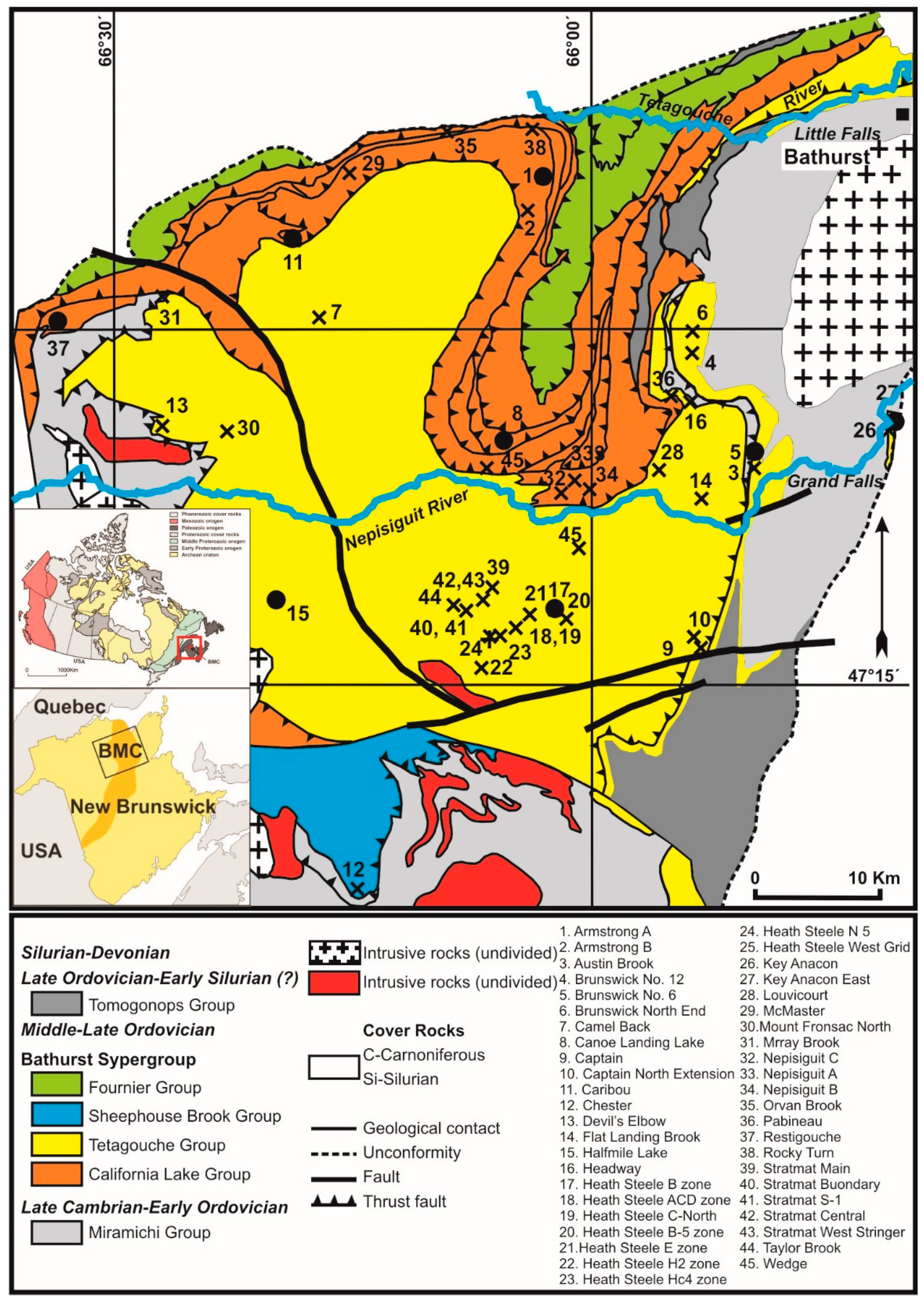
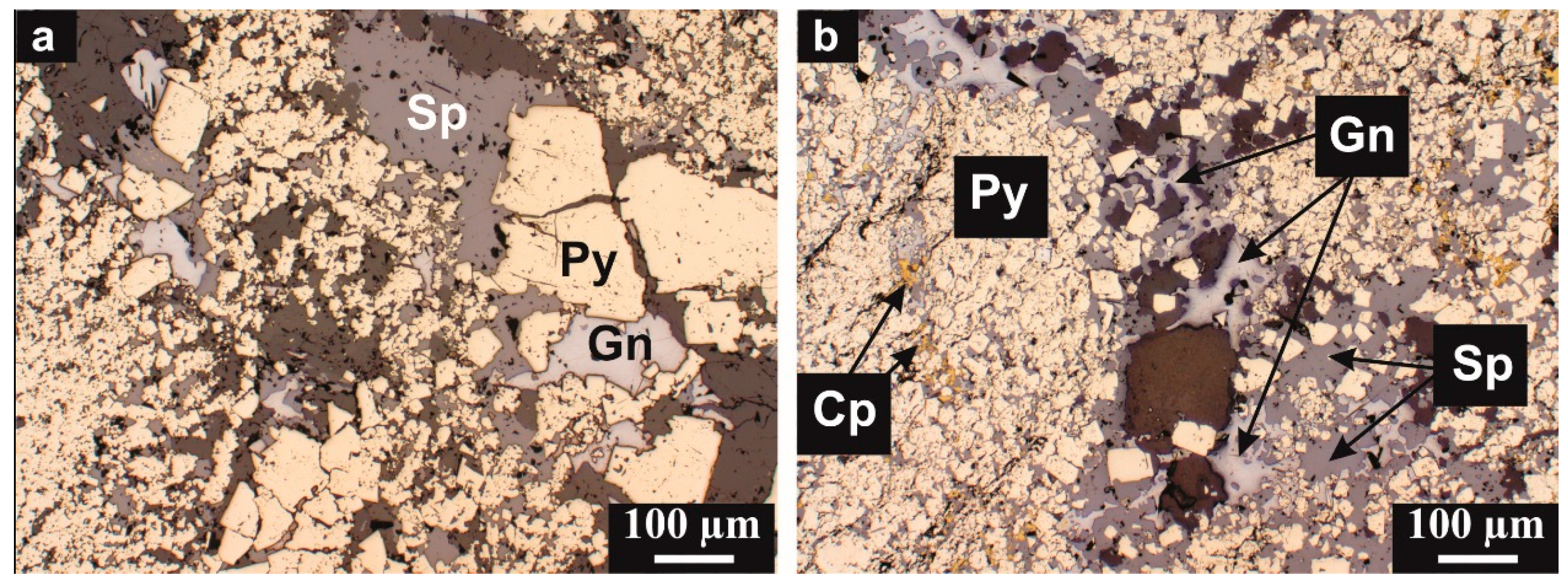
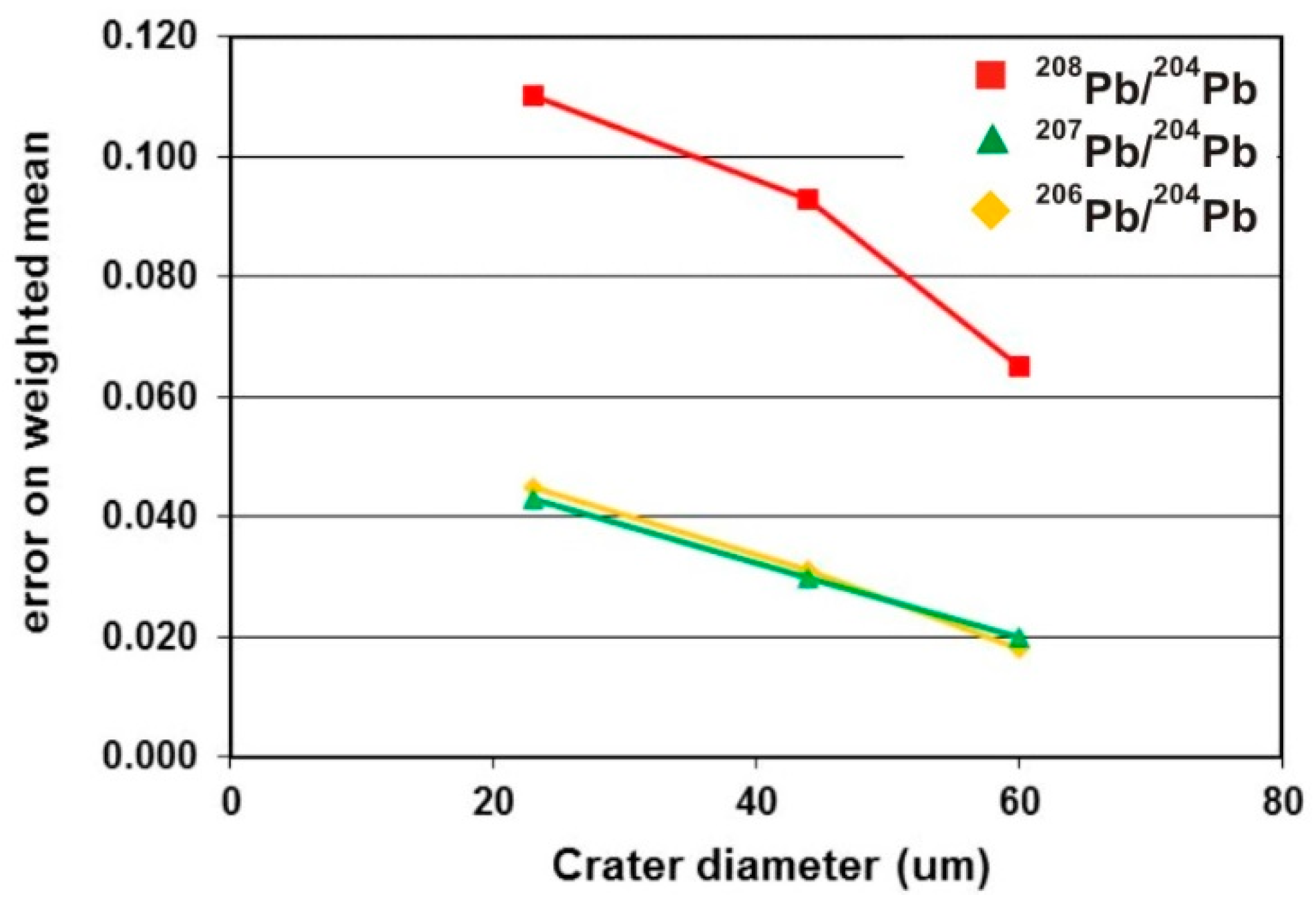
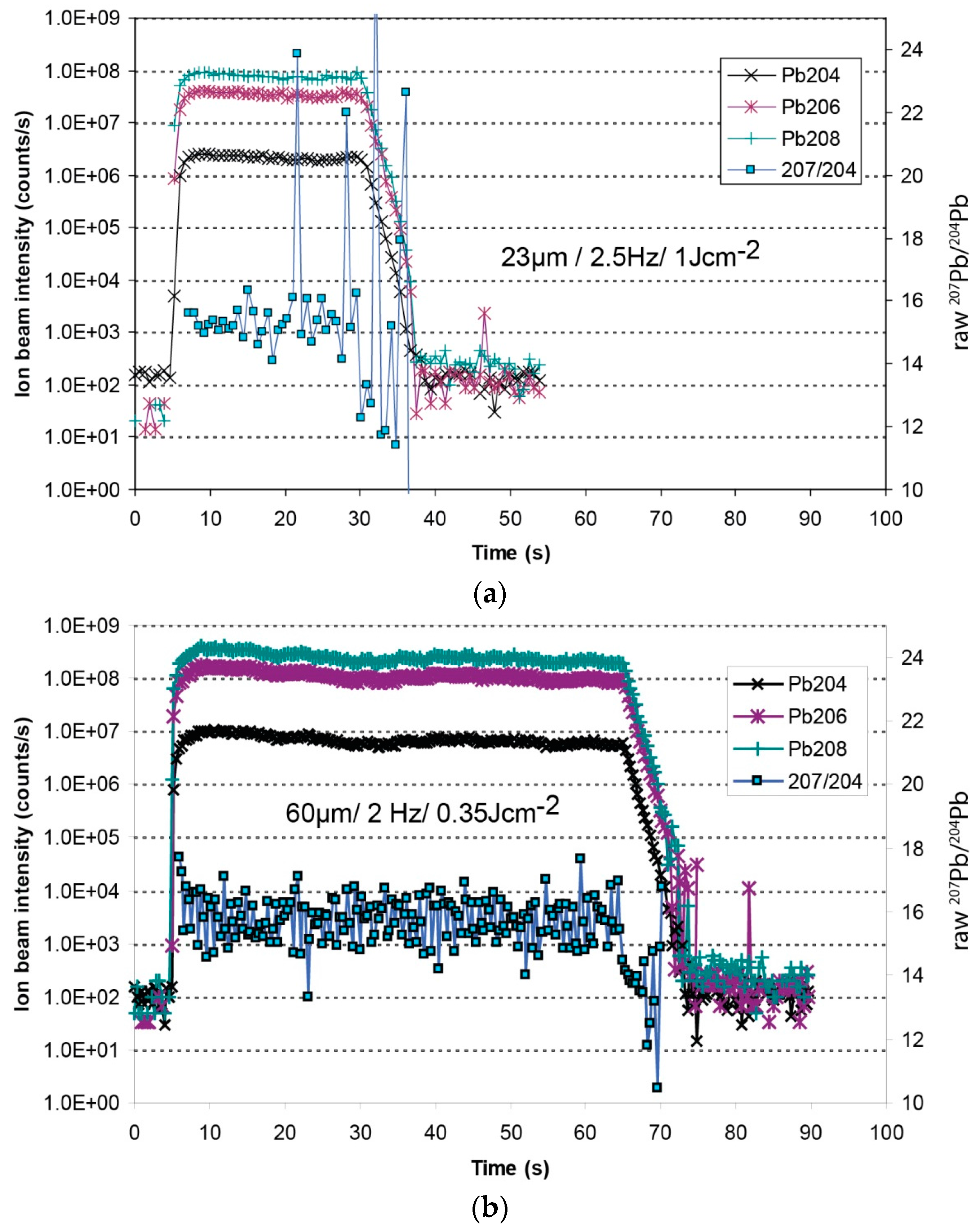
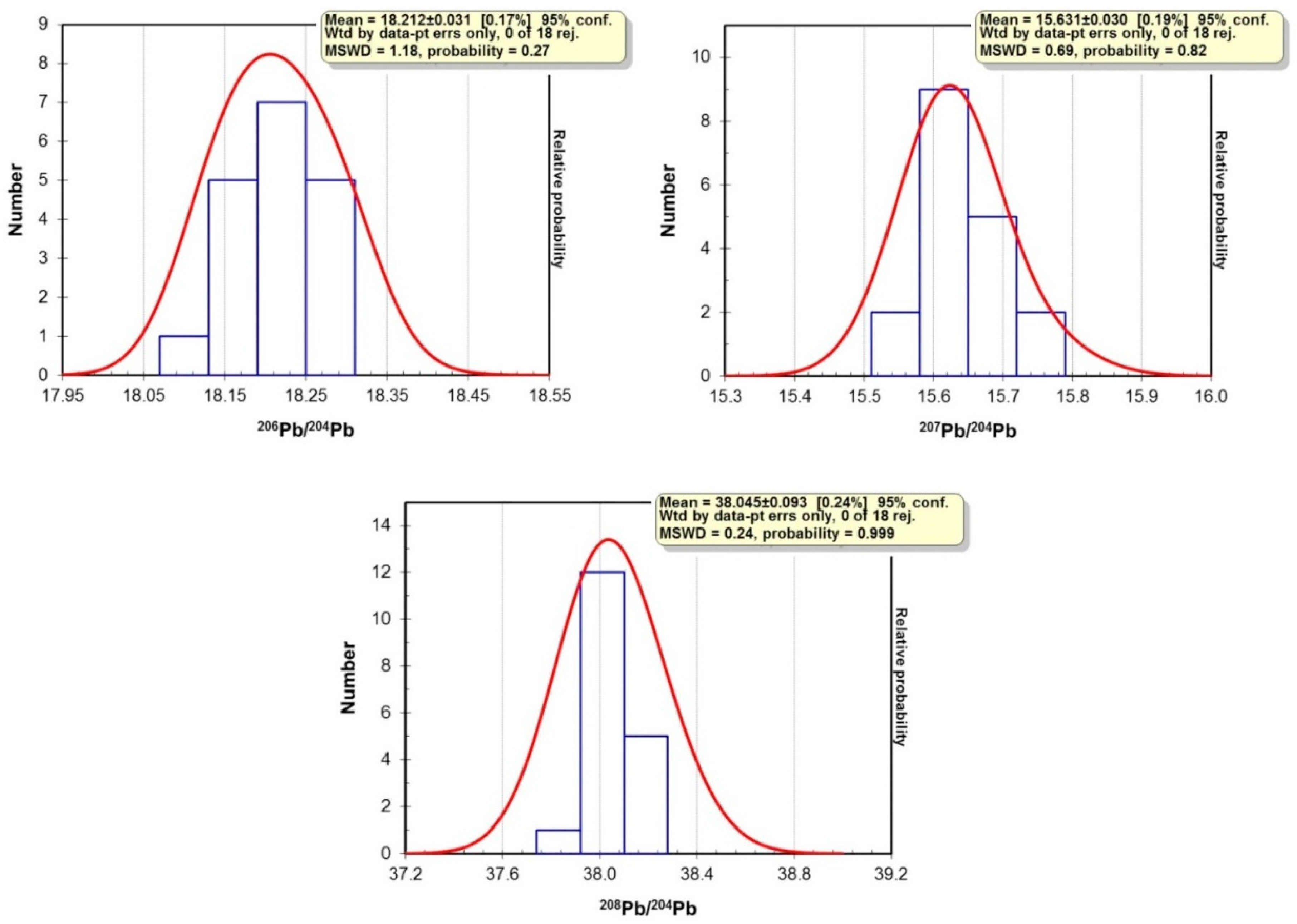
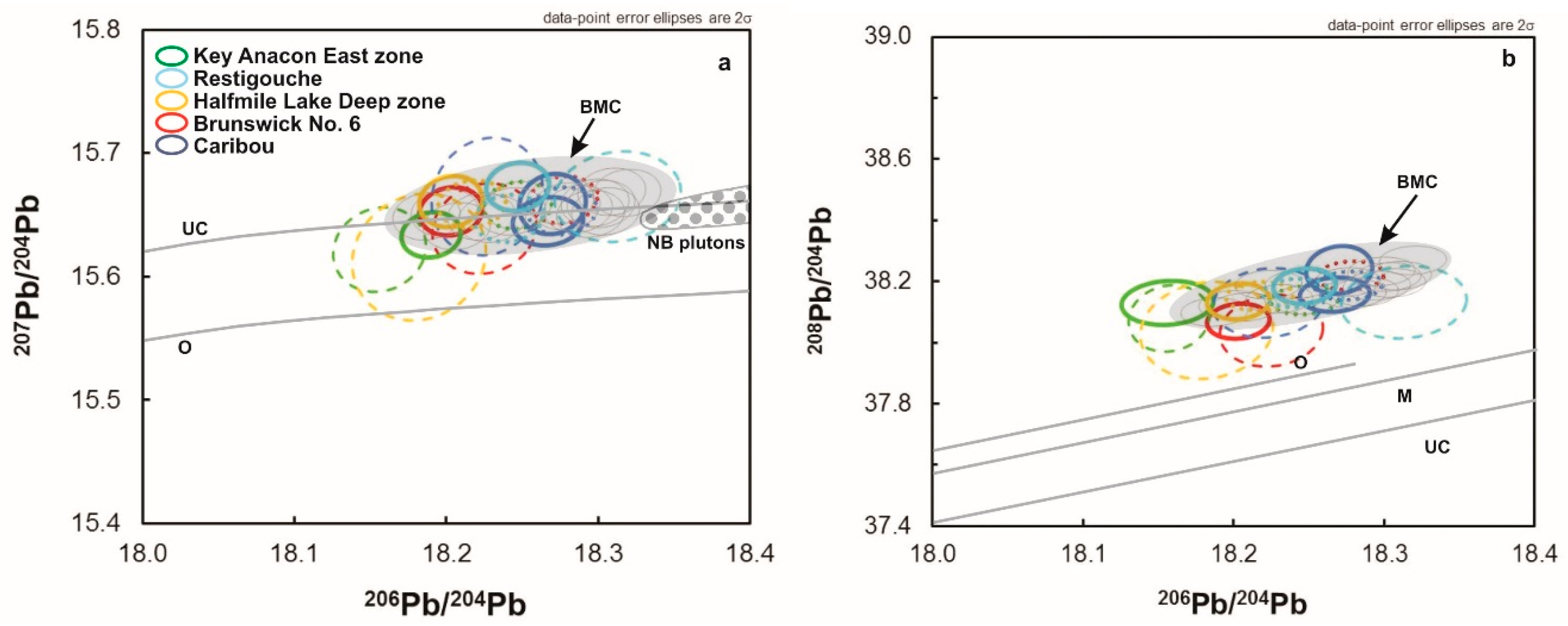
| No. | Deposit | Drill Hole | 206Pb/204Pb | 2σ | 207Pb/204Pb | 2σ | 208P/204Pb | 2σ | 207Pb/206Pb | 2σ | 206Pb/208Pb | 2σ |
|---|---|---|---|---|---|---|---|---|---|---|---|---|
| Ablation condition: 23 µm, 3 Hz, 1 J·cm−2, 25 s ablation duration | ||||||||||||
| n = 20 | Caribou | 62-55-115 | 18.294 | 0.044 | 15.738 | 0.044 | 38.270 | 0.100 | 0.8593 | 0.0022 | 0.4783 | 0.001 |
| n = 19 | Key Anacon East zone | 94-DL-32 | 18.243 | 0.040 | 15.725 | 0.043 | 38.320 | 0.120 | 0.8623 | 0.0020 | 0.4769 | 0.001 |
| n = 20 | Brunswick No. 6 | B-259 | 18.155 | 0.038 | 15.628 | 0.043 | 38.060 | 0.110 | 0.8627 | 0.0020 | 0.4762 | 0.001 |
| n = 20 | Restigouche | CP39-123 | 18.181 | 0.037 | 15.680 | 0.037 | 38.090 | 0.100 | 0.8621 | 0.0021 | 0.4771 | 0.001 |
| n = 20 | Halfmile Lake Deep zone | HN-119 | 18.157 | 0.044 | 15.568 | 0.045 | 38.070 | 0.110 | 0.8614 | 0.0023 | 0.4765 | 0.001 |
| Ablation condition: 44 µm, 2 Hz, 0.35 J·cm−2, 40 s ablation duration | ||||||||||||
| n = 18 | Caribou | 62-55-115 | 18.193 | 0.038 | 15.663 | 0.033 | 38.120 | 0.100 | 0.8572 | 0.0015 | 0.4787 | 0.001 |
| n = 20 | Key Anacon East zone | 94-DL-32 | 18.156 | 0.026 | 15.595 | 0.030 | 38.082 | 0.097 | 0.8599 | 0.0015 | 0.4773 | 0.001 |
| n = 20 | Brunswick No. 6 | B-259 | 18.123 | 0.031 | 15.668 | 0.033 | 38.000 | 0.100 | 0.8605 | 0.0016 | 0.4793 | 0.001 |
| n = 19 | Restigouche | CP39-123 | 18.320 | 0.030 | 15.697 | 0.033 | 38.140 | 0.100 | 0.8586 | 0.0015 | 0.4784 | 0.001 |
| n = 9 | Halfmile Lake Deep zone | HN-99-119 | 18.170 | 0.042 | 15.611 | 0.048 | 38.000 | 0.140 | 0.8594 | 0.0023 | 0.4794 | 0.002 |
| Ablation condition: 60 µm, 2 Hz, 0.35 J·cm−2, 60 s ablation duration | ||||||||||||
| n = 23 | Caribou | 62-55-115 | 18.264 | 0.018 | 15.637 | 0.021 | 38.170 | 0.068 | 0.8563 | 0.0010 | 0.4782 | 0.001 |
| n = 20 | Caribou | 62-55-115 | 18.267 | 0.019 | 15.645 | 0.016 | 38.157 | 0.046 | 0.8566 | 0.00063 | 0.4783 | 0.001 |
| n = 20 | Key Anacon East zone | 94-DL-32 | 18.190 | 0.016 | 15.634 | 0.015 | 38.130 | 0.059 | 0.8589 | 0.00073 | 0.4765 | 0.001 |
| n = 20 | Brunswick No. 6 | B-259 | 18.203 | 0.017 | 15.653 | 0.016 | 38.070 | 0.047 | 0.8603 | 0.00062 | 0.4781 | 0.001 |
| n = 20 | Restigouche | CP39-123 | 18.247 | 0.017 | 15.673 | 0.016 | 38.185 | 0.047 | 0.8586 | 0.00065 | 0.4786 | 0.001 |
| n = 20 | Halfmile Lake Deep zone | HN-119 | 18.203 | 0.017 | 15.661 | 0.017 | 38.135 | 0.048 | 0.8606 | 0.00063 | 0.4763 | 0.001 |
| Reference values [34,35] | ||||||||||||
| Brunswick No. 12 | 18.187 | 0.018 | 15.649 | 0.016 | 38.10 | 0.04 | ||||||
| Austin Brook | 18.247 | 0.018 | 15.658 | 0.016 | 38.14 | 0.04 | ||||||
| Heath Steele A1 | 18.199 | 0.018 | 15.652 | 0.016 | 38.12 | 0.04 | ||||||
| Stratmat | 18.207 | 0.018 | 15.641 | 0.016 | 38.12 | 0.04 | ||||||
| Wedge | 18.275 | 0.018 | 15.662 | 0.016 | 38.20 | 0.04 | ||||||
| Armstrong A | 18.287 | 0.018 | 15.655 | 0.016 | 38.17 | 0.04 | ||||||
| Rocky Turn | 18.319 | 0.018 | 15.668 | 0.016 | 38.27 | 0.04 | ||||||
| Orvan Brook | 18.305 | 0.018 | 15.653 | 0.016 | 38.20 | 0.04 | ||||||
| Murry Brook | 18.309 | 0.018 | 15.669 | 0.016 | 38.22 | 0.04 | ||||||
| Chester | 18.302 | 0.018 | 15.659 | 0.016 | 38.22 | 0.04 | ||||||
| Strachans Lake BK. | 18.223 | 0.018 | 15.649 | 0.016 | 38.19 | 0.04 | ||||||
| Canoe Landing Lake | 18.243 | 0.018 | 15.653 | 0.016 | 38.19 | 0.04 | ||||||
| Willett Showing | 18.295 | 0.018 | 15.651 | 0.016 | 38.19 | 0.04 | ||||||
| Armstrong B | 18.298 | 0.018 | 15.660 | 0.016 | 38.23 | 0.04 | ||||||
| Portage Lakes | 18.230 | 0.018 | 15.647 | 0.016 | 38.14 | 0.04 | ||||||
| Captain | 18.279 | 0.018 | 15.657 | 0.016 | 38.16 | 0.04 | ||||||
| Brunswick No. 6 | 18.277 | 0.018 | 15.663 | 0.016 | 38.22 | 0.04 | ||||||
| Key Anacon | 18.247 | 0.018 | 15.658 | 0.016 | 38.14 | 0.04 | ||||||
| Caribou | 18.276 | 0.018 | 15.654 | 0.016 | 38.19 | 0.04 | ||||||
| Halfmile Lake | 18.217 | 0.018 | 15.659 | 0.016 | 38.15 | 0.04 | ||||||
| Restigouche | 18.241 | 0.018 | 15.648 | 0.016 | 38.16 | 0.04 | ||||||
| Reference values [36] | ||||||||||||
| Wedge | 18.281 | 0.007 | 15.725 | 0.01 | 38.159 | 0.01 | ||||||
| Heath Steele | 18.229 | 0.007 | 15.658 | 0.01 | 38.13 | 0.01 | ||||||
| Brunswick 12 | 18.237 | 0.007 | 15.671 | 0.01 | 38.203 | 0.01 | ||||||
| Restigouche | 18.257 | 0.007 | 15.7 | 0.01 | 38.197 | 0.01 | ||||||
© 2016 by the authors; licensee MDPI, Basel, Switzerland. This article is an open access article distributed under the terms and conditions of the Creative Commons Attribution (CC-BY) license (http://creativecommons.org/licenses/by/4.0/).
Share and Cite
McFarlane, C.R.M.; Soltani Dehnavi, A.; Lentz, D.R. Pb-Isotopic Study of Galena by LA-Q-ICP-MS: Testing a New Methodology with Applications to Base-Metal Sulphide Deposits. Minerals 2016, 6, 96. https://doi.org/10.3390/min6030096
McFarlane CRM, Soltani Dehnavi A, Lentz DR. Pb-Isotopic Study of Galena by LA-Q-ICP-MS: Testing a New Methodology with Applications to Base-Metal Sulphide Deposits. Minerals. 2016; 6(3):96. https://doi.org/10.3390/min6030096
Chicago/Turabian StyleMcFarlane, Christopher R. M., Azam Soltani Dehnavi, and David R. Lentz. 2016. "Pb-Isotopic Study of Galena by LA-Q-ICP-MS: Testing a New Methodology with Applications to Base-Metal Sulphide Deposits" Minerals 6, no. 3: 96. https://doi.org/10.3390/min6030096
APA StyleMcFarlane, C. R. M., Soltani Dehnavi, A., & Lentz, D. R. (2016). Pb-Isotopic Study of Galena by LA-Q-ICP-MS: Testing a New Methodology with Applications to Base-Metal Sulphide Deposits. Minerals, 6(3), 96. https://doi.org/10.3390/min6030096







